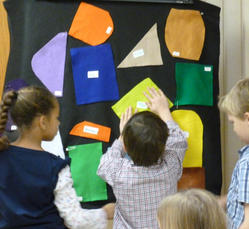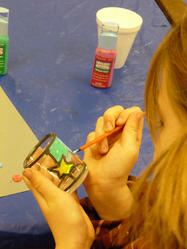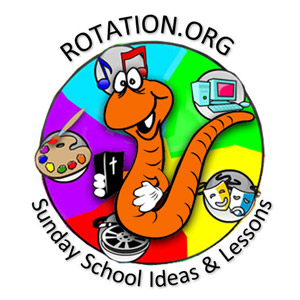The Birth Story of Jesus
Art Workshop
Summary of Lesson Activities:
Students will be creating an abstract design representing Jesus’ birth narrative on glass votive holders using sticky backed lead lines and glass paints.
(Updated for 2011; note the use of a different key verse than the 2006 lessons in this set.)
For scripture and objectives, see above.
Leader Preparation:
- Read the scripture for this lesson.
- Read and reflect on the overview material provided for this lesson.
- Gather the materials.
Supplies List:
- Bibles
- Easel with extra easel paper; appropriate marker
- Sticky-tack (for hanging items on wall)
- Flannel board supplies:
- Large piece of black felt
- Ten different colors of small pieces of felt (some colors, more than one piece)
- The attached file: Art Felt Labels (for labeling the felt pieces)
- Small safety pins (10); a few straight pins
- Small pieces of paper (10)
- Table covers
- Paint shirts
- Permanent marker (that marks on glass)
- Glass paint (variety of colors; does not have to match story piece chart)
- Sticky-backed lead lines; some in shapes of circles and squares is handy for younger kids
- Scissors
- Paint brushes
- Glass votive holders (one for each student)
Before Start of Class:
- Pre-wrap the bottom and top edges of the votive holders with lead lines.
- Follow the instructions on the attached felt labels/color chart, for choosing & labeling the small pieces of felt.
- Write: “Immanuel = God with us” in large letters on a piece of easel paper. Use sticky-tack to hang this paper where all can see it.
- Set up the flannel board – pin the black felt to the easel.
- Cut eight strips of black felt approximately ½ inch wide and of equal lengths, to use to demonstrate the placement of lead lines. Have these pieces and sticky-tack handy.
- Cover the tables and have paint shirts, and art supplies ready for students to create their candleholders.
Presentation
Opening- Welcome and Lesson Introduction:
Greet your students warmly, welcoming them to the Art Workshop. Introduce yourself and any other adults.
Ask: Do you use lights to decorate your home for Christmas? (accept a few replies)
Say: Lights are special at Christmas. They remind us that Jesus came to earth to bring God’s light to the world. Today we are going to decorate a light holder – a candleholder – so that you may make a keepsake that reminds you of the story of Jesus’ birth. Before we get started, let’s have a time of prayer.
Ask: What shall we pray for today? [It is ok to write down requests.]
Say: We will use the Lord’s Prayer as the ending to our prayer time.
A prayer suggestion: Holy God, we are thankful to be here with the chance to learn about your son’s birth. As we count down the days of Advent, help us to focus on the reason why we celebrate the birth of Jesus. Who would have thought that you’d sent your son into the world as a small, helpless baby! Help us to look for you among us in surprising ways. Then pray for requests. End with the Lord’s Prayer. Amen.
Dig- Main Content and Reflection:
Ask: Who are some of the characters in Jesus’ birth story? (point trying to make: there are lots of characters!)
Show an undecorated votive.
Say: There are lots of people and events in the story of Jesus’ birth. This is a small candleholder; it would be pretty hard to show the details about Jesus’ birth on the outside of this.
Ask: Do you suppose that we could use colors and simple shapes to represent different parts of the story?
Say: Let’s give it a try! First let’s review our story.
Ask: Where would we find our story in our Bible? (in NT)
What are the names of the first four books of the New Testament?
Say: We call these first four books the “Gospels.” Gospel means “good news.”
Ask: What is the good news of the Gospels? (allow a few replies)
Say: The good news is that God loves us so much that God gave us his son Jesus! Jesus lived on earth as a human just like you and me, teaching us about God and about how we should love others. Then Jesus died for us so that our sins could be forgiven. That is all very good news. Today we will read of Jesus’ birth from Matthew and Luke. Because we are using color to represent events in our story, let’s tell the story using colors of felt.
For classes with less than 18 students, pare down the number of pieces of felt by removing extra shepherd, wise men, and “gift” pieces of felt. Set these extras aside, they will not be used.
Show the students the collection of felt to be used.
Say: Each of these colors of felt will represent a character, or an item, or a place in our story. Each piece of felt is labeled. Everyone will have a piece of felt. As we tell our story, when you hear your item mentioned please come up and place your color on to this black felt, leaving a little bit of black between each color of felt. You will see that the black will be an important color.
Demonstrate leaving a bit of black between each piece by placing three pieces of felt on the flannel board, leaving space between the pieces. Then distribute the pieces of felt, one per student. Give the Shepherd the leftover necessary pieces of felt.
Ask: I wonder what we will create with our colors as we tell our story?
Tell the story:
Hold your lesson in an open Bible while you tell the story. (It is suggested that you hold the paper inside a Bible so that kids connect the story you are reading with the Bible.)
When students hear their character/place/item (underlined below), have them put their piece of felt on the felt board. Allow students to decide where to place their felt. Pause briefly as each child comes up, but then keep things moving along by continuing to “tell” the story.
For 3rd grade and up:
Have students find Luke 1:26.
Say: I will be telling the story and asking questions so you may need to check the Bible for answers.
Note: Don’t skip this important practice in finding the story in the Bible,
even if the kids never need to actually look!
Say: Our story starts in the book of Luke when an angel named Gabriel visited Mary. (There will be 3 pieces marked “angel.” Ask just one of these angels to put up their

color. Have the other students wait until another angel enters our story!)
Ask: Who can tell me what Gabriel said to Mary?
Say: The angel Gabriel told Mary that God would give her a special baby boy. He would be very important. He would be the Son of God and there would be no end to his kingdom!
Say: Mary was engaged to Joseph. When Joseph found out that Mary would have a baby he decided to break off his engagement to Mary. But then an angel came to him in a dream and told him that he should get married. My, there are lots of angels in our story!
Ask: Just before Mary had her baby, where did they travel? (for 3rd grade and up: Luke 2:4)
Say: They went to Bethlehem to register in the census.
Ask: What happened next? (Jesus was born)
Say: Now we have another angel in our story! God speaks to people through angels.
Ask: Whom did this angel visit? (3rd grade and up: Luke 2:9)
Say: The shepherds came to visit baby Jesus and found him wrapped in a blanket and lying in a manger.
Ask: What appeared in the sky over the stable where Jesus was born?
For 3rd grade and up:
If they aren’t sure have them find Matthew 2:2.
Say: A very bright star appeared, a different sort of message from God.
Ask: Who paid attention to this message?
Say: Wise men used the star to find the new king. They came to worship Jesus. They had to travel a long way so it was probably a couple of years after Jesus was born.
Ask: What were the three gifts they brought to Jesus? (gold, frankincense, myrrh)
Say: Then we have another message from God, an angel visited Joseph in a dream warning him to take his family to Egypt,
to escape from King Herod who wanted to harm Jesus. So Jesus and his family traveled to Egypt where they stayed until another angel told them it was safe to return home. The End!
Introduce and explain the art project:
Say: What have we created here? I think it looks like a stained glass window!
Ask: How many of you have ever seen a stained glass window?
Say: Stained glass windows can tell a story with pictures. In fact, a long, long time ago when not very many people could read, churches used stained glass windows to teach people Bible stories! We will decorate our candleholder to look like stained glass, using a special paint for glass. Think for a moment, about how you want to use different colors to tell the story of Jesus’ birth. Our Shepherd will start passing out paint smocks.
Have the Shepherd give out paint smocks. Meanwhile, point out on the felt board how the black acts to separate the colors, making each color stand out.
Say: Stained glass has special lines between each color. They are called “lead lines” because in real stained glass, these lines were made of a material called lead. In real stained glass the lead actually holds the pieces of glass in place. We will use our lead lines to keep our colors separate and to keep the paint from running together.
Show an undecorated votive. Point out the top and bottom edges.
Say: Lead lines have already been applied to the upper and lower edges of your glass. These lead lines are not made of real lead but they look like lead. As you look at your votive – a votive is another name for a candleholder – plan for what shapes you want your colors to have. These lead lines can be bent a little to create a shape. You can cut the strips to fit it just right.
Have the Shepherd distribute votives, writing their name and grade on the bottom of the votive using the special pen that marks on glass. Meanwhile, lift the felt board to expose the easel underneath. Using the black pieces of felt that you cut, and bits of sticky tack, demonstrate the placement of lead lines to create a shape, such as a simple 4-point star or a building. Show how the strips can be bent (slightly) to create a curved shape such as a heart. Point out how there can’t be gaps in the lead lines or the paint will run together.
Say: You don’t have to make recognizable shapes; you may choose to just create abstract shapes! You will want to have a plan for your decoration because once you stick on the lead lines you shouldn’t move them. To stick them on, peel the backing from a strip and press it on to the glass. You’ll want to apply all of the lead lines that you need before you add any paint.
Distribute lead lines. Although strips may be curved to fit lines, do not stretch the strips. Try not to handle the strips more than necessary, or they may not adhere properly. Cut the strips to fit with scissors. Pieces should be joined together so that they meet. Do not leave gaps, as the paint will run together. Try not to overlap leadlines.
Distribute paint and supplies whenever someone is ready for painting. Apply a bit of paint directly from the tube on to the glass and then use a paintbrush to spread out the paint. (Paint will become more translucent as it dries.)
Discussion: (while the students are working)
Important Note: Some banter between students about off-topic material is ok however, don’t miss what is an opportune time as the students work, to discuss the story! It is in this discussion that God’s character can be revealed.
Say: There were lots of angels in our story. Angels are one way that God talks to us.
Ask: Who received a visit from an angel in our story?
Say: The first three people to receive an angel visit were Mary, Joseph & the shepherds.
Ask: What was the same about all three of these messages from angels?
Say: That’s right – all of them were messages about the birth of Jesus.

Ask: I wonder what angels look like? (we picture wings & halos but no one knows)
Has anyone ever seen an angel? (accept any replies)
Do you suppose that angels can look like ordinary people?
Say: The writer of the New Testament book of Hebrews tells us that people who welcomed strangers, had welcomed angels without knowing it! That is an interesting thought – that ordinary people could give us a message from God; they could act on God’s behalf.
Ask: What are other ways that God connects with us?
Possibilities: through….
- The Bible (it helps to know something about God and how he works)
- Events that happen (perhaps God lead us to & through something)
- The “voice inside” (when something just doesn’t feel right)
- An actual voice we hear
- Through nature – a beautiful sunset for example
- Other?
Workshop Leader: Share your personal story about one of these.
Say: All of these are ways that God comes to us; ways that we experience God as being with us. Jesus was called Immanuel; a very appropriate name.
Refer to the easel.
Say: Immanuel means “God with us.” That gives me a good feeling: Jesus is our Savior and Jesus is God, with us.
Say: All of the angel visits were while the people were doing ordinary things – like sleeping or working.
Ask: What does that say about the way God works in our world?
Say: God can break into our lives at any time. We might miss it if we aren’t watching!
Say: The news of Jesus’ birth had a big effect on the people who heard it.
Ask: How has hearing about Jesus’ birth changed you?
Closing:
Say: In Matthew’s Gospel it says that Mary would give birth to a son, and they would call him Immanuel, which means ‘God is with us.’” God sent Jesus to be with us. God meant for his son Jesus to live on earth just like us; to grow and learn and teach, as one of us! It is a pretty amazing story. Tell it to someone else!
If you have extra time:
Have students share their work with the class, explaining a bit about their choices.
Replace the felt board on the easel and remove the felt pieces. Give them to the students, asking them to retell the story of Jesus’ birth in the correct order.
Ask readers to check the Bible for extra details.
Resources:
A lesson written by Carol Hulbert and Sherry Stone for First United Methodist Church
Ann Arbor, MI
Copyright 2011 First United Methodist Church, Ann Arbor, MI.
Permission to copy materials granted for non-commercial use provided credit is given and all cited references remain with this material
If you use this material, even in a modified form, please include the following reference:
Hulbert, Carol and Sherry Stone. "The Birth Story of Jesus: Art Lesson." December 2011. Place URL where lesson found inside angle brackets<>.
A representative of Rotation.org reformatted this post to improve readability.






